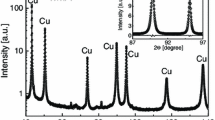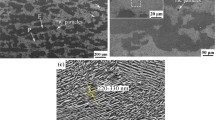Abstract
The influences of annealing temperature on the wear properties and electrical conductivity of Cu were studied after processing by high-pressure torsion (HPT). The annealing of Cu specimens processed by HPT leads to an increase in electroconductivity and a decrease in the wear rate. It is apparent that a nanotribolayer at the surface induced during wear sliding plays a more significant role than the ultrafine-grained structure. A slight increase was observed in the microhardness of HPT copper specimens upon annealing at a relatively low temperature (100 °C), and this is most likely due to a change in texture. The annealing leads to an increase in the Taylor factor by ~5 %, which is in good agreement with the increase in the microhardness level which is also by ~5 %. It is apparent that low-temperature annealing of HPT copper may produce optimal properties of the specimens including high strength and electroconductivity with a lower wear rate.






Similar content being viewed by others
References:
Valiev RZ, Islamgaliev RK, Alexandrov IV (2000) Bulk nanostructured materials from severe plastic deformation. Prog Mater Sci 45:103–189
Valiev RZ, Sabirov I, Zhilyaev AP, Langdon TG (2012) Bulk nanostructured metals for innovative applications. JOM 64:1134–1142
Faghihi S, Zhilyaev AP, Szpunar JA, Azari F, Vali H, Tabrizian M (2007) Nanostructuring of a titanium material by high-pressure torsion improves pre-osteoblast attachment. Adv Mater 19:1069–1073
Shangina DV, Bochvar NR, Dobatkin SV (2010) Structure and properties of Cu–Cr alloys subjected to shear under pressure and subsequent heating. Russ Metall (Metally) 11:1046–1052
Shangina DV, Maksimenkova YuM, Bochvar NR, Dobatkin SV (2011) Behavior of an ultrafine-grained Cu–Zr alloy in heating, Russian Metallurgy (Metally). Russ Metall (Metally) 11:1069–1073
Dopita M, Janeček M, Kužel R, Seifert HJn, Dobatkin S (2010) Microstructure evolution of CuZr polycrystals processed by high-pressure torsion. J Mater Sci 45:4631–4644. doi:10.1007/s10853-010-4643-9
Rigney DA (1988) Sliding wear of metals. Ann Rev Mater Sci 18:141–163
Emge A, Karthikeyan S, Kim HJ, Rigney DA (2007) The effect of sliding velocity on the tribological behavior of copper. Wear 263:614–618
Emge A, Karthikeyan S, Rigney DA (2009) The effects of sliding velocity and sliding time on nanocrystalline tribolayer development and properties in copper. Wear 267:562–567
Rigney D, Karthikeyan S (2010) The evolution of tribomaterial during sliding: a brief introduction. Tribol Lett 39:3–7
Zhilyaev AP, Shakhova I, Belyakov A, Kaibyshev R, Langdon TG (2013) Wear resistance and electroconductivity in copper processed by severe plastic deformation. Wear 305:89–99
Komura S, Horita Z, Nemoto M, Langdon TG (1999) Influence of stacking fault energy on microstructural development in equal-channel angular pressing. J Mater Res 14:4044–4050
Dobatkin SV, Szpunar JA, Zhilyaev AP, Cho J-Y, Kuznetsov AA (2007) Effect of the route and strain of equal-channel angular pressing on structure and properties of oxygen-free copper. Mater Sci Eng A 462:132–138
Huang WH, Chang L, Kao PW, Chang CP (2001) Effect of die angle on the deformation texture of copper processed by equal channel angular extrusion. Mater Sci Eng A 307:113–118
Miyamoto H, Erb U, Koyama T, Mimaki T, Vinogradov A, Hashimoto S (2004) Microstructure and texture development of copper single crystals deformed by equal-channel angular pressing. Philos Mag Lett 84:235–243
Dalla Torre F, Lapovok R, Sandlin J, Thomson PF, Davies CHJ, Pereloma EV (2004) Microstructures and properties of copper processed by equal channel angular extrusion for 1–16 passes. Acta Mater 52:4819–4832
Furukawa M, Fukuda Y, Oh-ishi K, Horita Z, Langdon TG (2006) An investigation of deformation in copper single crystals using equal-channel angular pressing. Mater Sci Forum 503–504:113–118
Lugo N, Llorca N, Cabrera JM, Horita Z (2008) Microstructures and mechanical properties of pure copper deformed severely by equal-channel angular pressing and high pressure torsion. Mater Sci Eng A 477:366–371
Jiang H, Zhu YT, Butt DP, Alexandrov IV, Lowe TC (2000) Microstructural evolution, microhardness and thermal stability of HPT-processed Cu. Mater Sci Eng A 290:128–138
Wetscher F, Vorhauer A, Pippan R (2005) Strain hardening during high pressure torsion deformation. Mater Sci Eng A 410–411:213–216
Horita Z, Langdon TG (2005) Microstructures and microhardness of an aluminium alloy and pure copper after processing by high-pressure torsion. Mater Sci Eng A 410–411:422–425
Swaminathan S, Shankar MR, Rao BC, Compton WD, Chandrasekar S, King AH, Trumble KP (2007) Severe plastic deformation (SPD) and nanostructured materials by machining. J Mater Sci 42:1529–1541. doi:10.1007/s10853-006-0745-9
Wang K, Tao NR, Liu G, Lu J, Lu K (2006) Plastic strain-induced grain refinement at the nanometer scale in copper. Acta Mater 54:5281–5291
Sadykov FA, Barykin NP, Aslanyan IR (1997) The influence of strain-heat processing on copper wear. Wear 212:160–164
Iglesias P, Bermúdez MD, Moscoso W, Chandrasekar S (2010) Influence of processing parameters on wear resistance of nanostructured OFHC copper manufactured by large strain extrusion machining. Wear 268:178184
Zhang YS, Wang K, Han Z, Liu G (2007) Dry sliding wear behaviour of copper with nano-scaled twins. Wear 262:1463–1470
Yao B, Han Z, Lu K (2012) Correlation between wear resistance and subsurface recrystallization structure in copper. Wear 294–295:438–445
Islamgaliev RK, Pekala K, Pekala M, Valiev RZ (1997) The determination of the grain boundary width of ultrafine grained copper and nickel from electrical resistivity measurements. Phys Stat Sol A 162:559–566
Zhilyaev AP, Gimazov AA, Raab GI, Langdon TG (2008) Using high-pressure torsion for the cold-consolidation of copper chips produced by machining. Mater Sci Eng A 486:123–126
Figueiredo RB, Cetlin PR, Langdon TG (2011) Using finite element modeling to examine the flow processes in quasi-constrained high-pressure torsion. Mater Sci Eng A 528:8198–8204
Figueiredo RB, Pereira PHR, Aguilar MTP, Cetlin PR, Langdon TG (2012) Using finite element modeling to examine the temperature distribution in quasi-constrained high-pressure torsion. Acta Mater 60:3190–3198
van den Beukel A (1979) Dislocation production in cold worked copper. Scripta Metal 13:83–86
Rigney DA (1979) Dislocation content at large plastic strains. Scripta Metal 13:353–354
Huang X, Hansen N, Tsuji N (2006) Hardening by annealing and softening by deformation in nanostructured metals. Science 312:249–251
Tang F, Schoeunung JM (2008) Strain hardening in nanocrystalline or ultrafine-grained metals: a mechanistic explanation. Mater Sci Eng A 493:101–103
Su LH, Lu C, Tieu AK, He LZ, Zhang Y, Wexler D (2011) Vacancy-assisted hardening nanostructured metals. Mater Let 65:514–516
Kamikawa N, Huang X, Tsuji N, Hansen N (2009) Strengthening mechanisms in nanostructured high-purity aluminium deformed to high strain and annealed. Acta Mater 57:4198–4208
Acknowledgements
This study was supported by the Ministry of Education and Science, Russia, under Grant No. 14.A18.21.1986, and in part by the European Research Council under ERC Grant Agreement No. 267464-SPDMETALS. The authors are grateful to the personnel of the Joint Research Centre, Belgorod State University, for their assistance with instrumental analysis.
Author information
Authors and Affiliations
Corresponding author
Rights and permissions
About this article
Cite this article
Zhilyaev, A.P., Shakhova, I., Belyakov, A. et al. Effect of annealing on wear resistance and electroconductivity of copper processed by high-pressure torsion. J Mater Sci 49, 2270–2278 (2014). https://doi.org/10.1007/s10853-013-7923-3
Received:
Accepted:
Published:
Issue Date:
DOI: https://doi.org/10.1007/s10853-013-7923-3




